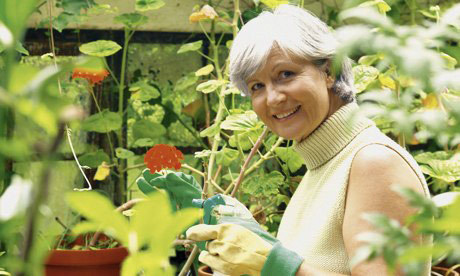˫��պ��ֹ����ڽ����ಡ��������
 �պ��ֹ������ڽ������ಡ��������
�պ��ֹ������ڽ������ಡ�������� ����Daily activities such as DIY or gardening may prolong life by up to 30% in the 60+ age group, a report published in the British Journal of Sports Medicine showed.
����As any committed gardener will confirm, seeing the first shoots of life emerge after the winter months can provide a deep sense of satisfaction.
����But gardeners now have another reason to feel rather smug �C regular gardening or DIY can cut the risk of a heart attack or stroke, and prolong life by as much as 30% among the 60-plus age group, according to a study of almost 4,000 60-year-olds in Stockholm.
����The research found that even those who spent their retirement training for marathons were not at less risk than the green-fingered group. Gardening �C voted pensioners' favourite pastime in a recent study byAge UK �C provided as many health benefits as regular exercise.
����The 60-year-olds who were most active on a daily basis had a 27% lower risk of a heart attack or stroke and a 30% reduced risk of death from all causes, irrespective of how much regular formal exercise was taken.
����"Our findings are particularly important for older adults, because individuals in this age group tend, compared with other age groups, to spend a relatively greater proportion of their active day performing [routine activities] as they often find it difficult to achieve recommended exercise intensity levels," the scientists wrote in the British Journal of Sports Medicine.
����Over a 12-year period the team, led by Dr Elin Ekblom-Bak at Karolinska University hospital's department of medicine, asked 60-year-olds for information on diet, smoking and alcohol intake in addition to information on whether they did regular activities such as gardening, DIY, car maintenance and blackberry picking. The researchers also carried out lab tests and physical examinations.
����At the start of the study, those who had an active daily life were at much less risk of heart attacks �C even if they did not exercise �C than those with low levels of daily activity. They also had smaller waists, lower levels of potentially harmful blood fats, and lower glucose, insulin and clotting factor levels in men, high levels of which are linked to a raised heart attack and stroke risk.
����The benefits of regular activity continued through the course of the study. During the 12.5-year follow-up period, 476 of the participants had their first heart attack and 383 died from various causes. Those who exercised regularly, but were not routinely physically active, were also at less risk of cardiovascular problems, and those who exercised regularly and were active on a daily basis were at the least risk of all.
����The study suggests gardening and DIY can be as good as exercise for the over-60s because they increase overall energy expenditure �C prolonged sitting drives down metabolic rate to the bare minimum, while standing up and physical activity increase it. The study went on to explain that sitting down can disrupt the skeletal muscle's normal hormone production, with potential negative impacts on other body organs and tissues.
����Dr Gavin Sandercock, reader in sport and exercise science at the University of Essex, said: "'This study is excellent news for large swaths of the population who might not want to run, swim or go to the gym because it clearly shows that even moderate, non-exercise activity like gardening benefits the health of older adults."
����But he warned that younger people and children still had to be encouraged to do vigorous exercise like fast walking, running, swimming and cycling. "While the amounts reported here are OK for older people, children still need to do an hour of activity every day to be healthy and that needs to be hard enough to make them breathe hard and preferably feel hot."
����Dr Tim Chico, senior clinical lecturer and honorary consultant cardiologist at the University of Sheffield/Sheffield Teaching Hospitals, said the more active a person was throughout their lives, the lower their risk of suffering from cardiovascular disease.
����"The message I take from this study is simple," he said. "If you want to reduce your risk of heart disease, be more active. Don't sit down for long periods; get up on your feet and do something you enjoy that involves moving around."
������Ӣ���˶�ҽѧ��־���Ϸ�����һƪ������ʾ�����ֹ����������������ճ���п���ʹ60�����ϵ��˵������ӳ�30%��
������Ӣ�����������������κ������յ��˶���ͬ�⣬�����Ķ����������ѿ�ȷ�����һ�̣����ǻ�е������㡣
������������������������һ��ֵ�����������ɣ�һ�����˹�¸��Ħ�н�4000��60�����˵��о����������������ջ��ֹ��������Խ������ಡ�������з�ķ��գ�����ʹ60�����ϵ��˵������ӳ�30%��
�����о����֣���ʹ����Щ���ݺ��������ɵ��ˣ������ķ���Ҳû�бȴ����յ��˵͡����ƻ���AgeUK�����һ���о���������������������ϲ������Dz����ͬ���ڶ���һ�������彡��������洦��
�������۳��ڡ���ʽ�˶����ж��60��������ÿ�������ʮ��ģ����ಡ�������з�ķ��ջή��27%�������ԭ�������ķ��ս���30%��
���������ǵķ��ֶ���������˵������Ҫ����Ϊ����������ε�����ȣ����Ǻ��Ѵﵽר�ҽ�����˶�ǿ��ˮƽ�����ϰ���ڻ���Ը����ʱ�����ճ���ϡ�����ѧ���ڡ�Ӣ���˶�ҽѧ��־����д����
������俨����˹����ѧҽԺҽѧ���İ���(Elin Ekblom-Bak)��ʿ����һ֧���飬��ʱ12�꣬ѯ����һȺ60�����˵ĸ�����Ϣ��������ʳ�����̡��ƾ������Լ��Ƿ��вμ����ա��ֹ�����������ά�ͺ�ݮ��ժһ��Ķ��ڻ���о���������ʵ���Ҳ��ԣ��Բ����߽��������顣
����ʵ���ʼ����Щƽʱ����ʮ����ˣ���ʹƽ�������������ಡ�����ķ���ҲҲ��ƽʱ��ٵ��˵͵öࡣͬʱ��������Χ��С��DZ���к���Ѫ֬���٣����������ǡ��ȵ��غ���Ѫ����ˮƽ���ͣ���Щ����ˮƽ�ߵ�ʱ�����������ಡ�������з�ķ��ա�
�����������о������У����ڶ������洦һֱ�������֡���12����������ڣ�476�����������ಡ��������383����Ϊ����ԭ����������Щ�ж��ڶ�����ƽʱȴ���ڻ���ˣ�������Ѫ�����������С����Щ�ж��ڶ�������ÿ�����ʮ��������������л���������͡�
���������о���������60�����ϵ�������˵���ա��ֹ������Ͷ���һ�����棬��Ϊ���Ƕ����������������ܺġ���ʱ�侲�����������л�ʽ�����ͣ���վ�������������ߴ�л�ʡ��о����������˵�����������ҹ����������������ɣ�����������������֯��DZ�ڵĸ���Ӱ�졣
����Ӣ��������˹��ѧ�������˶���ѧ����ʦ����(Gavin Sandercock)��ʿ˵�����������о��Ժܶ���ܲ�Ը���ܲ�����Ӿ��ȥ�����ݶ���������˵�Ǵ����Ϣ����Ϊ�о�����ر�������ʹ���������º͡����˶��ԵĻ�������������˵Ľ�������
����������Ҳ����˵������Ҫ���������˺Ͷ�ͯ���о����˶�������ߡ��ܲ�����Ӿ�������г��������ܱ������ᵽ���˶����ʺ������ˣ���ͯҪ���ֽ������ǵ�ÿ���˶�һСʱ�������˶�ǿ�ȣ���������������ܹ�ȫ�����ȡ���
����Ӣ��л�ƶ��´�ѧ���ٴ���ʦ��л�ƶ��½�ѧҽԺ���ಡ���������ʵ�ķ(Tim Chico)��ʿ��ʾ��һ����һ����Խ�dz�������������Ѫ�ܼ����ķ��վ�Խ�͡�
�������Ҵ������о��еõ�����ʾ�ܼ�����˵�������������Ҫ���ͻ����ಡ�ķ��գ��͵ø��л���һ�㡣��Ҫ��ʱ�侲����������Щϲ�������飬����תһת����
����(���� uamouse �༭ ����)
- ÆæÎÅ£º82ËêÀÏÌ«¾¹È»»³ÔÐ40Ä꣨˫Ó2013-12-17 14:31
- ¶¯ÎïË«ÓïȤ֪ʶ£ºÎªºÎ´üÐܵıã±ãÊÇÁ¢·½ÐΣ¿2013-12-17 13:49
- ¶¯ÎïË«ÓïȤ֪ʶ£ºÖí¿ÉÒÔ´òÓÎÏ·£¿2013-12-17 10:14
- Ë«ÓïÐÇ×ù£ºË«×Ó×ù¸»ÎÌ×î¶à ÌìЫ×ù²ÆÔ˵æµ×2013-12-16 18:41
- »éÁä³Æν¸÷²»Í¬ Ö½»éµ½×êʯ»é´óÅ̵ã(Ë«Óï)2013-12-16 18:29
- Ë«Ó°Â˹¿¨Ó°ºóÇí•·¼µÇ´ÇÊÀÏíÄê96Ëê2013-12-16 16:55
- Ë«ÓÆÕÁÖ˹¶Ù´óѧ¾¼Ãϵ½ÌÊڸĽ̺«¾ç¿Î2013-12-16 16:21
- Äã²»µÃ²»ÖªµÄ8¸öÀË·ÑÇ®µÄСϰ¹ß£¨Ë«Ó2013-12-16 14:45
